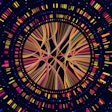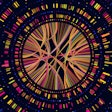
University of Cambridge researchers have outlined a new DNA sequencing method that detects where and how small molecule drugs interact with a targeted genome. The research, published on January 23 in Nature Biotechnology, allows precise mapping of drug-genome binding sites, potentially enabling the development of more effective medications.
Many lifesaving drugs directly interact with DNA to treat diseases. For example, numerous cancer patients are treated with genome-targeting drugs, including the widely used anticancer drug doxorubicin, which is sold under the brand name Adriamycin, among others.
But despite decades of clinical use and research, the molecular mode of action within the genome is still not well understood. Researchers have compared a therapeutic drug entering a cancer cell with a 3 billion base genome to entering a black box. However, understanding how small molecules influence cellular functions is essential to drug target engagement.
The new method, called chem-map, provides a peek into this genomic black box by allowing researchers to conduct precise in situ mapping of small molecules that interact with DNA or DNA-associated proteins called histones using a strategy called small-molecule-directed transposase Tn5 tagmentation. This strategy detects the binding site in the genome where a small molecule binds to genomic DNA or DNA-associated proteins.
Researchers also used chem-map to determine the direct binding sites of doxorubicin within human leukemia cells. Chem-map revealed how using doxorubicin on cells already exposed to the histone deacetylase (HDAC) inhibitor tucidinostat may have potential clinical advantages -- this combination therapy is currently undergoing clinical trials.
Finally, the chem-map technique was used to map the bromodomain and extraterminal protein-binding inhibitor JQ1 and provide the first interaction maps for molecules pyridostatin and PhenDC3, which bind DNA G-quadruplex structures, known as G4s. These four-stranded secondary structures have been implicated in gene regulation and could be possible targets for future anti-cancer treatments. The researchers contend that such in situ chem mapping of small molecule interactions with DNA and chromatin (the mixture of DNA and histone proteins that form the chromosomes) may provide insights that will help enhance the intervention of genome and chromatin function and facilitate the development of safer and more effective drug therapies.
“Understanding how drugs work in the body is essential to creating better, more effective therapies,” Zutao Yu, PhD, co-first author, said in a statement. “We have established a highly efficient approach which will open many paths for new research.”



















